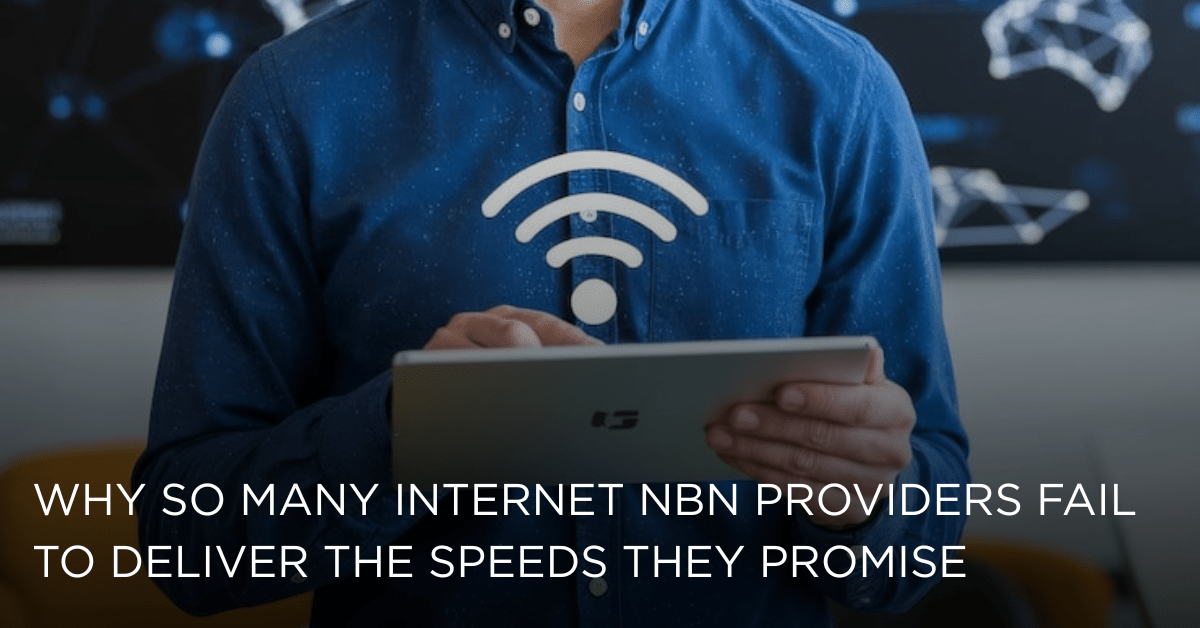A good phone system is essential for businesses in today’s modern era. Whether you have…

Why So Many Internet NBN Providers Fail to Deliver the Speeds They Promise
You know what the ads say. They are all over the place. Plans for 100Mbps that are fast! Evening speeds are quite reliable! The internet nbn providers experience ever! Like many Australians, you join up with eagerness, hoping for a smooth internet experience. But then, reality sets in. The video is buffering. The game is slow. It takes a long time to download. You do a speed test, and the number on the screen is a small part of what you were promised. And have one annoying question: Why?
You are not the only one who has heard this before. A lot of Australians pay for internet that is slower than what they get. The problem isn’t necessarily with the NBN network itself; it’s typically with the internet NBN providers you choose.
Getting the Basics Down There isn’t just one pipe First, let’s get rid of a frequent misunderstanding. The wholesaler is the National Broadband Network (NBN). They put in and take care of the cables, fibers, and towers that connect your home to the internet.
You acquire from Internet NBN providers, which are also called Internet Service Providers (ISPs). Businesses like Telstra, Optus, TPG, Aussie Broadband, and many others. They buy space on the NBN network and then sell it to you, the consumer. In your mind, think about it this way:
- The NBN is a new highway with several lanes.
- Your ISP is the corporation that rents lanes on that highway.
- Your internet package is your ticket to ride that bus.
The highway isn’t always the problem. A lot of the time, it’s because the bus company hasn’t rented enough lanes or is putting too many people on each vehicle.
7 Reasons Your Internet NBN Providers Let You Down
1. The person who caused the traffic jam: CVC stands for Connectivity Virtual Circuit.
This is the most important and technical reason for poor speeds, yet it’s important to know.
- What it is: CVC is the shared bandwidth that your ISP buys from NBN to connect a group of houses (called a POI or Point of Interconnect) to the rest of the internet. It’s a big pipe that everyone in your neighborhood who uses the same ISP has to share.
- The issue is that CVC costs your ISP money. Some broadband NBN providers may not buy enough CVC capacity for all of their customers to keep rates low and earnings high. This common pipe gets jammed during peak hours, like 7 to 11 PM when everyone is streaming Netflix, playing games, and reading through social media. There isn’t enough bandwidth for everyone, thus everyone’s speeds drop a lot. This is called “contention.”
Good ISPs spend a lot of money on CVC to make sure there is always enough bandwidth, even when things are busy. This is why some providers are willing to pay a little more for that guaranteed capacity.
2. The Up to Speed Trick
You should read the small print. Most of the time, when an ISP promotes a 100Mbps service, they say that speeds can go up to 100Mbps. This is a legal way to get out of jail. They are not promising you will get 100Mbps; they are merely promising that you will not get more than that.
They haven’t broken their promise, but your actual speed could be lower because of all the other things on this list.
3. The technology you use to connect to the NBN is important.
Not all NBN connections are the same. The kind of technology utilized to link your home has a big effect on how fast you can go. There are a few different kinds:
- FTTP (Fibre to the Premises): The best of the best. A fiber optic line goes straight into your house. It has the most reliable speeds and the highest speeds all the time.
- HFC (Hybrid Fiber Coaxial): This uses the former pay-TV and cable network. It can be incredibly fast, but it can also be more prone to network noise and congestion.
- FTTC (Fibre to the Curb): A small node near your street gets fibre, and then the copper wires that are already there finish the connection to your home. In general, it’s good and dependable.
- FTTN (Fibre to the Node): Fiber runs to a box in your community, usually on a street corner, and then the old copper phone lines link it to your home. This is the worst of the bunch. The farther away you are from the node, the slower your FTTN speed gets. No matter which NBN provider you choose in my region, you could never be able to get the fastest speeds if you reside 800 meters away.
- Fixed Wireless and Satellite: For places that are not close to cities. These have more delay and are more affected by weather and location.
Your ISP can be marketing you a fast package, but your line can’t handle it because you’re on a slow FTTN connection.
4. Your Own Network at Home
The issue is often not with the ISP or the NBN, but rather with your home.
- Old Router or Modem: Your ISP may have offered you a free modem three years ago, but it may not be able to handle today’s high-speed plans. It could be overheated, obsolete, or plain cheap and weak.
- Problems with Wi-Fi: Your signal can be blocked by walls, microwaves, fish tanks, and even your neighbor’s Wi-Fi. The signal gets weaker the more away you are from your router. For plans with high speeds, it’s always better to connect devices with an Ethernet cable than with Wi-Fi.
- Too Many Devices: There are phones, laptops, tablets, smart TVs, game consoles, and smart home gadgets all fighting for bandwidth in most homes. If three people are streaming 4K video at the same time, a 50Mbps plan might have trouble.
5. The Guide to Typical Evening Speed
The ACCC now says that ISPs must show Typical Evening Speeds (typically between 7 pm and 11 pm) to assist clear up any misconceptions. This is the average speed you can expect when things are at their busiest.
- A plan that says it has 100Mbps might really only have 90Mbps (great) or 50Mbps (bad) at night.
- Before you buy a plan, always verify the Typical Evening Speed. This is the most accurate number an ISP will offer you about how well their network works. When looking for the “best home internet provider Melbourne” has to offer, check out these speeds.
6. Managing and peering ISP networks
Your ISP’s own national network is important. How do people get to well-known websites like Netflix, YouTube, and cloud gaming sites like Steam?
- Good ISPs have direct peering agreements with these big content providers. This implies that the path from their network to Netflix’s servers is short and straight, which makes your experience faster and smoother.
- Cheaper ISPs might send this traffic via slower, more crowded routes, which would add delay and cause buffering, even if your overall speed test seems good.
7. The Illusion of the Slower Speed Tier
If your line (such FTTN) can’t handle the top speed you bought, some providers may automatically place you on a slower plan. This stops you from paying for speed you can’t use, but if you weren’t anticipating it, it can feel like a failure to deliver. A decent service will make this apparent when you join up.
How to Find Trustworthy NBN Internet Providers in Your Area
So, how do you stay away from these problems? This is a useful resource for both finding an ISP provider near you and looking up possibilities online.
Look at your NBN technology:
First, be aware of what you’re working with. Type your address onto the NBN Co website. It will inform you what kind of connection you have (FTTP, FTTN, etc.). This tells you what speed you may realistically expect.
Don’t pay attention to the Up to Speed;
First pay attention to the Typical Evening Speed. This is the most essential statistic. Look at the Typical Evening Speeds of different providers for the plan level you choose. The ACCC also puts out reports every three months that show how well the biggest ISPs are doing. These papers are full of neutral information.
Read reviews, but do it wisely:
Look for trends in reviews. If 50 people are all saying that their internet slows down in the evening with a certain ISP in Melbourne, that’s a big red sign. Also, seek for evaluations from people who have the same NBN technology as you.
Don’t just pick the cheapest choice:
The cheapest plan usually signifies that the ISP is skimping on CVC bandwidth. Paying a little extra ($10 to $20 a month) to a provider that is known for making good investments in their network can make a big difference in how you use the internet every day.
Ask about their support:
Where are their call centers? How long do you have to wait? When something goes wrong, good customer service is really important. When looking for “isp providers Melbourne,” one of the best things to look for is local support. This shows that they care about their reputation in the community.
Make sure your own connection works:
· Connect your PC directly to the modem using a wired Ethernet cable.
- Turn off your modem and back on.
- Make sure that no other gadgets are using the internet.
Use a speed test that you can trust, such speedtest.net or the ACCC’s own Measuring Broadband Australia speed test. If the wired speed is still far lower than the Typical Evening Speed guarantee, your ISP has a problem.
In conclusion
There is rarely one bad guy behind the difference between advertised and actual speeds. It’s a combination of ISPs trying to save money, old home wiring, technical problems, and problems with the home network.
You are not helpless as a customer. You may make an informed choice by learning about CVC congestion and Typical Evening Speeds and doing a lot of research on the internet NBN providers that are available to you.
Don’t just type “isp provider near me” into a search engine and choose the first or cheapest result. Look for providers who are open about how well they do, put money into their network, and have a good reputation in your area. This will finally fill the gap between the internet you were promised and the internet you really get.



